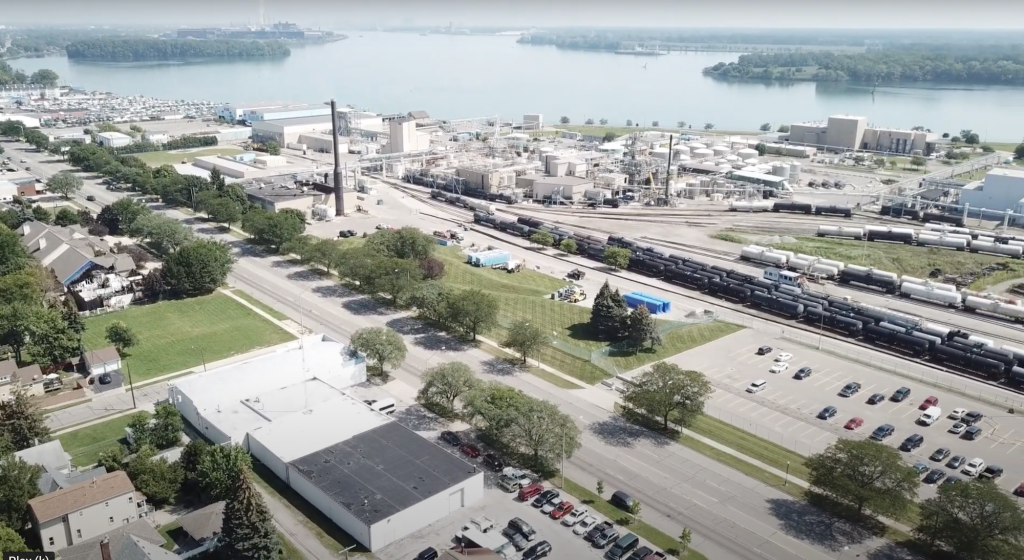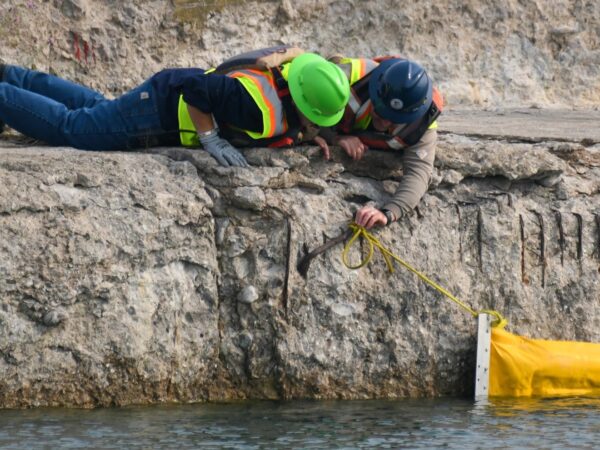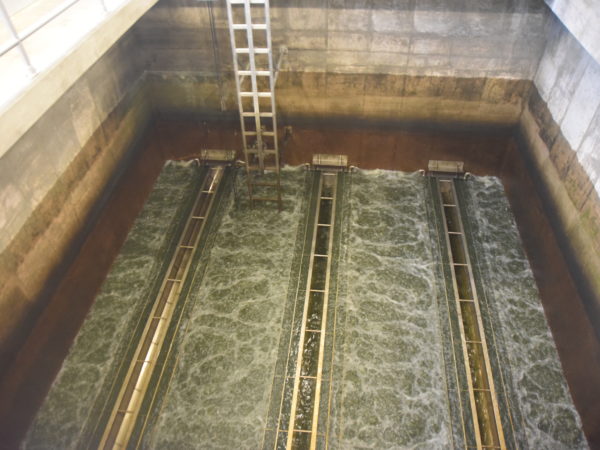
This article was republished here with permission from Planet Detroit.
By Tom Perkins, Planet Detroit
For 43 years, state regulators and the Environmental Protection Agency have ordered chemical manufacturer BASF to stop discharging up to 72,000 gallons of toxic waste-contaminated groundwater daily from its Wyandotte plant into the Detroit River.
But the waste still flows unabated. Based on BASF estimates, as much as 1.1 billion gallons of water contaminated with high levels of mercury, benzene, cyanide, PFAS, naphthalene and other dangerous chemicals have potentially moved into the river since the state first took action in 1983 and Sierra Club Michigan has warned the “staggering” volume is “comparable to a major spill daily.”
Records indicate that waste enters the river just upstream from the City of Wyandotte’s drinking water intake without being tested for certain chemicals found in high concentrations at the BASF site. Meanwhile, experts warn the waste is likely poisoning a key piece of the aquatic food chain.
The pollution persists despite consent agreements that BASF signed with the Michigan Department of Environment, Great Lakes, and Energy (EGLE) and the EPA in 1980 and 1994, respectively. Those order the company to “prevent the flow of contaminated groundwater … to the Detroit River.”
Critics say the situation represents stunning cases of corporate malfeasance and regulatory failure. A trove of EGLE and EPA documents obtained via the Freedom of Information Act and reviewed by Planet Detroit show how regulators repeatedly criticized BASF’s cleanup proposals for their weaknesses and noted that the company’s steps were inadequate. Still, multiple action plans detailed in the documents appear to have fizzled, and BASF has yet to address the problem.
“Situations like this will continue to keep happening until we actually force corporations that produce massive amounts of toxic pollution to take care of their mess,” Christy McGillivray, legislative director for Sierra Club Michigan, told Planet Detroit.
Regulators defended their handling of the site. The EPA, the lead agency handling the case, pointed to what it characterized as new, “robust” BASF remediation plans. In a statement, an agency spokesperson said the site is complex because the company spread toxic waste-contaminated fill across the property. That makes it more challenging to manage than if the chemicals were spilled in one spot or were discharged from a single source.
“With a site with this level of complexity, it is not unusual for the site characterization, planning and cleanup implementation to take decades,” the EPA spokesperson said, also noting that the agency in 2015 began taking a new “comprehensive” approach it claims will address all the issues. One interim measure designed to treat some groundwater came online on July 7, but a fix remains years off.
EGLE spokesperson Hugh McDiarmid noted the state is in a support role to the EPA and said EGLE has assisted Wyandotte in monitoring its drinking water and is helping fund improvements to its filtration system.
BASF did not respond to a request for comment. Planet Detroit also requested comment and information from the entire Wyandotte City Council and its water department superintendent but received no response. BASF is the city’s largest taxpayer, having paid $1.5M in property taxes to the city in 2022.
‘A really horrible situation’
The Biddle Avenue BASF plant property runs about 1.7 miles along the Detroit River shoreline, where it produces a wide range of industrial products, including polyurethane for seat cushions, insulation, footwear and other uses; specialized plastics for automotive or electronics use; and resins for packaging or surface coatings.
The property’s former owner, Wyandotte Chemicals, was one of the world’s largest producers of lye and chlorine in the 1960s and 1970s, and the production process required the use of mercury dumped in landfills on the site’s shoreline. According to an EGLE memo, BASF used some of that contaminated soil as a fill around the site’s perimeter and shoreline.
Planet Detroit reviewed test results over the last 40 years that showed persistently high levels of contaminants in the property’s water and soil, including 13 chemicals that exceeded state clean water standards in 2021 testing. Among those were known carcinogens, neurotoxins, and substances that harm humans and aquatic life at very low levels of exposure.
The levels of mercury moving into the river, the EPA noted in a 2006 memo, were “indicative of mercury waste material or mercury spills.” The site is also contaminated with high levels of PFAS from firefighting foam discharged on the property during emergency training or used in products manufactured at the plant.
The most pressing concern is Wyandotte’s drinking water system, which intakes about 800 feet from BASF’s site. EGLE’s McDiarmid told Planet Detroit that the state is working with the city to test the water before it enters Wyandotte’s system and the “finished” water that residents drink. The testing has not detected mercury and some VOCs, McDiarmid said. Test results provided to Planet Detroit show regular monthly or weekly testing for multiple PFAS compounds over the last several years and some instances of detections of PFOS, one of the most dangerous types of the chemical.
But the city and state do not test for all the chemicals found at elevated levels at the BASF site. Detail on the drinking water contaminants that are tested for at the Wyandotte plant provided to Planet Detroit by EGLE did not include cyanide, sulfate, arsenic, phenanthrene, bis(2- chloroethyl) ether, 3-methylphenol, 4-methylphenol and dibenzofuran, all of which were found at elevated levels in recent testing at the BASF site.
The contaminants could bypass the intake because of turbidity in the area, and many of the contaminants are likely to end up in the sediment, according to Denise Trabbic-Pointer, a toxics and remediation specialist with Sierra Club.
But some could still be getting in the drinking water. Low levels of exposure are a problem with some of the contaminants, which Wyandotte and regulators only recently began testing for. The city is upgrading to a better filtration system, which leaves decades of unknowns, said Allen Burton, an ecosystem science and water management professor at the University of Michigan.
“I would be concerned if I were a citizen of Wyandotte because you don’t know how much [contamination] they’ve taken in,” he said. “You depend on the water treatment plant to always function at top capacity, and that’s not always the case.”
The chemicals are also likely to poison aquatic life, including fish consumed by humans. The contaminants often settle on the river bed where benthic organisms – like worms and insect larvae that live in river sediment – are exposed. Burton characterized benthic organisms as “a key part of food chain contamination” because they are consumed by catfish, carp, or other bottom feeders that are consumed up the chain by humans or other wildlife.
That’s especially an issue in Lake Erie’s western basin, which is also subjected to pollution from hundreds of other sources along the shorelines and is shallow with a mucky sediment bed, Burton noted.
“It’s a really horrible situation,” he said. “The sum of discharges and mixtures of chemicals are causing a lot of trouble in that western basin of Lake Erie.”
Failed solutions
Over the decades, BASF has attempted to stop toxins from reaching the river with little success.
That includes the installation of a wall designed to thwart the groundwater flow. A 2018 memo from the EPA sent to BASF notes the decaying wall is around 100 years old, made of wood, full of gaps and does little to stem the contaminated water’s flow.
“The wall does not contain contaminated groundwater from the facility, preventing its discharge to the river, or preclude the riverward erosion of the on-site fill,” the memo reads.
The company also installed an extraction well system dug into the aquifer. It aims to pump water out of the ground, treat it, then discharge the treated water into the river. The goal is to do this quickly enough that the contaminated groundwater does not have a chance to move into the river.
The EPA knew as early as 2006 that this system was failing. In an internal memo an agency geologist sent to management, the geologist wrote the system was “ineffective in preventing contaminated groundwater from entering the river” because, among other issues, the extraction wells were placed in poor locations. The geologist noted that the mercury levels detected in water caught by the wells were extremely high, but still far below the actual levels entering the river.
“Obviously, because this has been going on for years, their extraction system has never been right,” Trabbic-Pointer said.
Documents show how officials have discussed remediation plans for decades with little progress. A 2000 memo from BASF details the remediation steps it planned to take. A 2003 memo from then-Michigan Attorney General Mike Cox’s office urges BASF to provide sampling data. A 2021 memo from EGLE staff to leadership details problems and solutions at the site.
But the problems persist. McGillivray said the failure highlights the need for structural changes at EGLE. She said state polluter laws are weak, and regulators do not have law enforcement backing them up when they try to hold polluters accountable.
She traced that back to former Michigan Gov. John Engler’s administration, which eliminated the state’s “polluter pay” law and separated EGLE from the Department of Natural Resources, which she said was designed to weaken regulators’ enforcement power. She added that Gretchen Whitmer’s administration has shown little interest in giving regulators teeth.
“The result is we don’t use any sort of power to check these corporate bad actors, and staffing changes and rebranding at EGLE aren’t going to fix this because we aren’t enforcing the most basic environmental protections,” McGillivray said.
Regulators insist they have a handle on the situation this time. In a statement, an EPA spokesperson said the agency and BASF have since 2018 been collecting data that will be the basis of a “comprehensive” solution, which differs from the strategy used in previous decades.
EPA in May completed a technical review of a remediation plan designed off that data, and BASF is currently preparing a final intermediate design “at EPA’s direction,” the spokesperson said.
“This comprehensive remedy is expected to prevent all of the site’s contaminated groundwater from entering the Detroit River,” the spokesperson wrote.
EGLE’s McDiarmid said the state agency is “optimistic the EPA and BASF are now moving toward a plan that will aggressively address the groundwater contamination affecting the river.”
McGillivray said she remains skeptical as the site continues spewing more toxic waste.
“If they are no longer venting toxic groundwater and there is data to show that, then that means the problem is solved,” she said. “Until then, it’s not.”
Documents referenced in this report can be found on Planet Detroit’s Resource Hub.
This article first appeared on Planet Detroit and is republished here under a Creative Commons license.![]()
Catch more news at Great Lakes Now:
Record air pollution, Canadian wildfires prompts state to change how it issues air quality alerts
DTE agrees to shut down coal-fired Monroe plant in 2032, three years ahead of schedule
Featured image: Aerial view of BASF Plastics plant in Wyandotte, Michigan. (Source: FracTrackerVideos)




